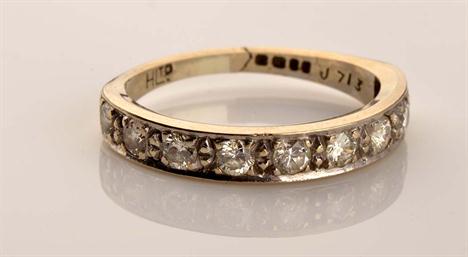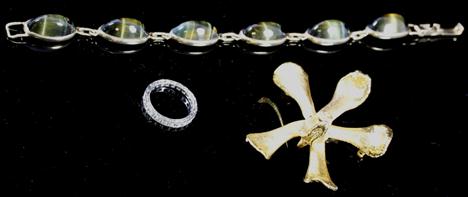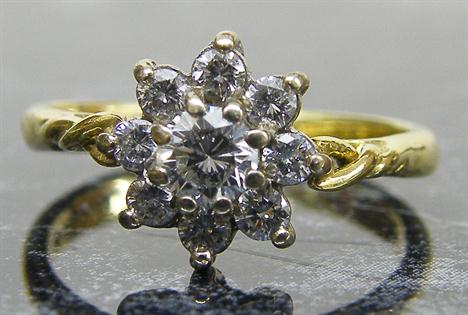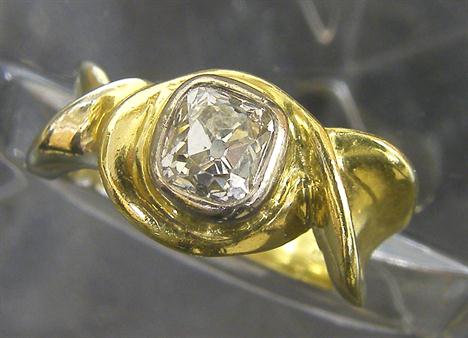We found 137173 price guide item(s) matching your search
There are 137173 lots that match your search criteria. Subscribe now to get instant access to the full price guide service.
Click here to subscribe- List
- Grid
-
137173 item(s)/page
Seven George III tea spoons, by Hester Bateman, London circa 1790, all in old English pattern, five matching with engraved initial 'K', one other with engraved initials 'SSE'; a pair of George III sugar tongs, by Hester Bateman, London circa 1785, bright cut and engraved with initials 'DW'; and a George III toddy ladle, by Hester Bateman, London 1786, old English pattern, 4.6oz. gross.
A stamped 9ct bracelet, set with six oval cabochon stones, each measuring approx 18x9mm and each showing a strong cats eye effect, together with a dipped orchid brooch with a mark on the reverse of three R`s (the second two R`s inverted), made by dipping an orchid in liquid gold, with a Boodle & Dunthorne boxed white stone set full eternity ring, the channel set stones to carved sides, unmarked white metal mount, finger size K.
HO gauge, Jouef mixed lot: consists of two locomotives (8255 SNCF 4-6-2 `Calais 231.K.82`, 8342M SNCF red Bo-Bo `BB9288`); six passenger coaches (4691, 4673, 5342, 4674, 5341, 5343). All appear VG/E, boxed. Together with one unboxed BR blue Bo-Bo `D6100` locomotive and two unboxed BR passenger coaches.
13 x Matchbox models: 9 x 40 Hay Trailer; 44 Passenger Coach; 24 Diesel Shunter; 39 Rolls Royce; K-13 Ready Mix Concrete Truck. Overall appear VG in G-VG boxes. Together with three empty Matchbox boxes, a Tintoys Armoured Car (opened, with card); and a Corgi Juniors 58 Beach Buggy (opened, with card).
Group court mounted as worn to 24908329 CFN K A Toms REME. GSM QE2 with Northern Ireland clasp, Nato Former Yugoslavia clasp, Iraq War Medal with 19 Mar to 28 Apr 2003 clasp, 2002 Jubilee Medal, Regular Army QE2 LSGC Medal. Plus a 2012 Diamond Jubilee Medal in original box of issue (6) GVF-EF
RODS (3): Monk of Chester 8’ 2 piece split cane trout fly rod, burgundy close whipped low bridge guides, cork handle, alloy fittings, bronze ferrule, good, in MOB, a Walker of Alnwick 8’ 2 piece plus spare tip split cane lightweight trout fly rod, black close whipped throughout, bronze lock k fast ferrules, cork handle, alloy reel fittings, good, in MOB and an Apollo 7’ 2 piece tubular steel spinning rod, in MOB.
GARRISON ROD: Garrison replica? - 2 piece 9’ split bamboo trout fly rod, 221 K.89.2 build date refers to 1967, light tan bamboo cane with blackened full bridge butt guide, matching snake intermediates, whipped black, bronze ferrule, all original correct whips throughout, 13.5” shaped cork handle with inset alloy upper screw winch fitting, fixed lower fitting, integral butt extension, as new condition, in pale green cloth bag. Possible replica rod based on the original.
PULSERA DE DIAMANTESRealizada en oro blanco, parte central en forma de flor con centro de brillante, peso aproximado 0.90 ct, con unos valores estimados de color y pureza de J-K // P1-P2, veinte diamantes talla brillante con un peso total aproximado de 1.28 ct, y brazalete formado por motivos de hojas adornados con doscientos veintiseis diamantes talla 8/8 con un peso total aproximado de 6.78 ct. Cierre oculto tipo lengüeta.41.5
**A LEAD ROUNDEL OF MINOS AND SCYLLA, AFTER THE MODEL ATTRIBUTED TO THE WORKSHOP OF HANS JAMNITZER (MASTER `HG` 1538-1603)relief moulded with the central equestrian figure of the besieging King Minos before classical maidens and a tower topped by Scylla gazing down at him, a block of pike-men to his rear, the coastal town and shipping to the background, a tree stump to the foreground dated and initialled `1569 / HG`17 cm, 6 ¾ in diameterProvenanceFrédéric Spitzer, Paris, sold Anderson Galleries, New York, 10th January 1929, lot 325JWHA Inv. No. 693Scylla, the daughter of King Nisus, fell in love with the Cretan King Minos, when she watched from the battlements as Hebesieged her father`s city.On the head of King Nisus grew a lock of purple hair, which protected his kingdom.Scylla cut this off while he slept and gave it to Minos.Inevitably Minos was now victorious, but he abandoned Scylla, disapproving of her treachery.As Minos sailed away, the wretched Scylla swam after him, only to be attacked by her father in the guise of a sea eagle.Her fate was to be transformed into a sea bird, eternally preyed upon by her sea eagle father.For further Jamnitzer lead plaquettes of this subject see: Rijksmuseum, Amsterdam, Inv. No. BK-1954-36, Historisches Museum, Basel, Inv. No. 1904.1044, and Koller Auctions, Zurich, 20 March 2006, lot 1006.See I. Weber, 1975, pl. 271 and K. Pechstein, 1985, p.420
**A COMPOSITE GERMAN LIGHT FIELD ARMOUR IN THE `BLACK-AND-WHITE` FASHION, CIRCA 1570-1610comprising comb morion with rounded crown formed in two halves joined along a high medial comb, and `swept` integral brim rising to an acute point front and rear (the rear chipped), the base of the crown encircled by twelve lining-rivets with rosette-washers of brass and fitted at the nape with a slender tapering plume-holder, `Almain` collar formed of three lames front and rear and fitted at each side with an integral spaudler of seven lames (associated), breastplate formed of a heavy main plate projecting forward over the belly, and fitted with moveable gussets at the arm-openings and a fauld of three lames (the lowest two associated) supporting on straps two short one-piece tassets (not a pair), one-piece backplate en suite with the breastplate, fitted with a culet of one lame, and gauntlets with slightly flared and rounded cuffs fitted in each case with a separate inner plate, four metacarpal-plates, a knuckle-plate with roped transverse rib, a hinged thumb-defence and, in the case of the right, some finger-scales (partly detached), the main edges of the armour formed with roped inward turns, and each side of the crown of the morion and each tasset decorated with a large fleur-de-lis, the outside of each gauntlet decorated with stylised foliage involving fleur-de-lis, and the remainder decorated with plain bands and borders in all cases embossed and burnished bright against a blackened ground (refreshed); the armour accompanied by a heavy oval shield (modern) fitted at its front with a central spike and at its rear with a pair of enarmes, its surface decorated with three bright embossed fleur-de-lis against a blackened ground en suite with the armour itselfSee note at front of catalogue for information concerning stands ProvenancePhilip Rhinelander II, New York, sold Parke-Bernet Galleries, New York, 17th November 1944, lot 97, cat. No. 603JWHA Inv. No. 2778.1.a-j (armour) and 2778.2 (shield)The decoration of the cuirass, the tassets and the gauntlets is characteristically North German in style. Similarly decorated pieces are to be found in the former arsenals of Brunswick, Emden, Lübeck and Munster (K. Ullmann, 1961, figs 7 & 14; K. Ullmann, 1963, pt. 1, p. 38, figs 8, 11, 15-18 & 25; K. Ullmann, 1968, pp. 14-17 & 30-1; W. Fanger, 1981, figs 2-3, 7, 21 & 23)
**A COMPOSITE SOUTH GERMAN INFANTRY ARMOUR IN THE `BLACK-AND-WHITE` FASHION, PARTLY NUREMBERG, CIRCA 1570-90comprising burgonet with a one-piece skull formed with four facets, rising to an acute point and fitted at the brow with an obtusely-pointed pivoted peak (patched at its upper edge), at the nape with a separate plate flanged outwards at its lower edge to receive a one-piece neck-guard, and at each side with a hinged cheek-piece decorated at its centre with an embossed rosette and flanged outwards at its lower edge to continue the line of the neck-guard, `Almain` collar formed of two lames front and rear (the top one in each case associated) and fitted at each side with a spaudler (likewise associated) of seven lames, breastplate formed of a medially-ridged main plate projecting forward over the belly, struck at the neck with the quality-control mark of the city of Nuremberg, and fitted at its arm-openings with moveable gussets, and at its lower edge with a fauld of two lames, the lowest of which (partly disarticulated) is struck with the Vienna arsenal-mark and supports on straps two long tassets each of six lames terminating just above the knees, and one-piece backplate flanged outwards at its lower end to receive a culet of one lame, circular besagues (modern), each decorated at its centre with a large embossed rosette matching those of the burgonet, two vambraces (not a pair) each formed of a tubular upper and lower cannon (the inner plate of the left lower cannon restored) linked by internal leathers (those of the left partly disarticulated) to an intervening winged bracelet couter decorated with a roped medial rib, the upper cannon in each case surmounted by a turner of two lames (the uppermost restored), and gauntlets (the right restored) each formed of a short rounded-ended tubular cuff fitted with a separate inner plate, five metacarpal-plates, a knuckle-plate decorated with a roped transverse rib, a finger-plate, scaled finger-defences and a hinged thumb-defence of five scales, the main edges of the armour formed with roped inward turns accompanied,, except in the case of the burgonet, besagues and cannons of the vambraces, by recessed borders burnished bright against a blackened ground (refreshed), along with the rosettes of the burgonet and besagues, and the roped ribs of the turners and coutersSee note at front of catalogue for information concerning stands ProvenanceDr. Bashford Dean, Riverdale, New York, sold American Art Association, New York, 23rd November 1928, lot 146JWHA Inv. No. 608.a-k
**A COMPOSITE NORTH GERMAN LIGHT INFANTRY ARMOUR IN THE `BLACK-AND-WHITE` FASHION, CIRCA 1570-1610comprising comb morion with rounded crown formed in two halves joined along a high medial comb, and `swept` integral brim rising to an acute point front and rear (the front one bent), the base of the crown encircled by fourteen (originally sixteen) lining-rivets with rosette-washers of brass and fitted at the nape with a slender tapering plume-holder, `Almain` collar formed of three lames front and rear (partly disarticulated, the left of the lowest front one patched) and fitted at each side with an integral spaudler of six lames, breastplate formed of a medially-ridged main plate projecting forward over the belly and fitted at its arm-openings with moveable gussets and at its lower edge with a fauld of two lames (associated) supporting on straps two long tassets of each of six lames (the right partly disarticulated) terminating just above the knees, and one-piece backplate boxed at either side and flanged outwards at its lower end to receive a culet of one lame, the main edges of the armour formed with inward turns decorated, other than on the helmet, with roping, the breastplate decorated with three diverging bands enclosed in each case by a pair of narrower bands, the crown of the morion decorated at each side with a large fleur-de-lis enclosed within a circle surrounded by stylised acanthus foliage repeated in the borders of each of the remaining elements of the armour, and in all cases embossed and burnished bright against a blackened ground (refreshed)See note at front of catalogue for information concerning stands ProvenanceJ. Glueckselig & Sohn, Vienna, 1st December 1936 JWHA Inv. No. 2384.a-fExhibitedFort Devens Service Club, Ayer, Massachusetts, 8 August-30 October 1941The decoration of the armour is characteristically North German in style. Pieces of the same fashion can be seen in the former arsenals of Emden, Lübeck and Munster (K. Ullmann 1961, figs 7, 14 & 24; K. Ullmann 1963, figs 8, 15 & 24-25; and K. Ullmann 1968, pp. 18-19)
-
137173 item(s)/page


























































